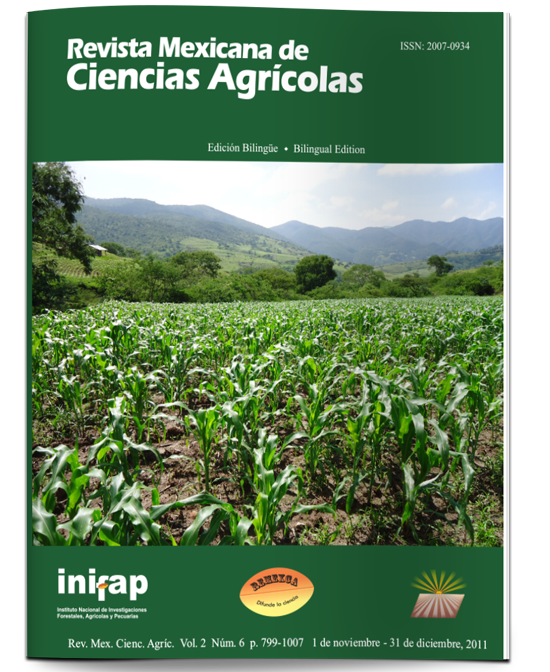RESPUESTA DE HÍBRIDOS TRILINEALES Y PROBADORES DE MAÍZ EN VALLES ALTOS DEL CENTRO DE MÉXICO
DOI:
https://doi.org/10.29312/remexca.v2i6.1564Palabras clave:
Zea mays L., híbridos de tres líneas, métodos multivariados, producción de mazorca, Valles AltosResumen
La identificación de híbridos de tres líneas sobresalientes formados con germoplasma, proveniente de diferentes instituciones de investigación, podría contribuir a incrementar la heterosis en rendimiento de grano y la estabilidad de los maíces que se siembran en los Valles Altos del centro de México. El presente trabajo se realizó en 2009 en diez ambientes de esta región, con el objetivo de identificar material genético sobresaliente. En un diseño experimental alpha látice 8∗5 con dos repeticiones por ambiente, fueron evaluados 40 genotipos de maíz: 32 híbridos trilineales blanco precoz, cuatro cruzas simples (probadores) y cuatro testigos del CIMMYT. Los resultados más sobresalientes indicaron lo siguiente: a) los ambientes donde se registró una producción de mazorca mayor a 9.5 t ha-1 fueron Tlahuelilpan, Batán (+) y Batán (AC), pero Tlaxcoapan fue el ambiente con rendimiento y estabilidad promedio, b) quince genotipos tuvieron rendimientos de mazorca estadísticamente iguales entre 8.2 y 9.4 t ha-1, pero los de mayor producción fueron los identificados con los códigos 21, 28, 27, 29 y 20 (CMS989001//México gpo. 10; CMS 989003//Tuxpeño Crema 1; CMS 989003//SB1; CMS 989003//México gpo. 10; CMS 989001//Tuxpeño Crema 1), con promedios aritméticos muy aceptables en ambientes favorables y en condiciones de baja fertilidad y sequía pero inestables, debido que de éstos sólo el genotipo 27 fue el más estable a través de los diez ambientes contrastantes. Los mejores probadores fueron los identificados con los códigos 35 y 36 [CMS 989001 (P3) y CMS 989003 (P4)], ambos con 9.3 t ha-1. El mejor testigo fue el hibrido trilineal identificado con la clave 39 y con el origen CMT 089005, con 8.5 t ha-1. El mejor testigo y los mejores probadores tuvieron rendimientos de mazorca estadísticamente iguales que los 15 híbridos más sobresalientes. El subconjunto de genotipos integrado por los cinco híbridos trilineales y por los dos probadores, con las mayores producciones de mazorca, constituyen el material genético más sobresaliente, para emplearse en un nuevo programa de mejoramiento genético, y generar tecnología de producción o para recomendación en siembra comercial en esta región de México.
Descargas
Descargas
Publicado
Cómo citar
Número
Sección
Licencia
Los autores(as) que publiquen en Revista Mexicana de Ciencias Agrícolas aceptan las siguientes condiciones:
De acuerdo con la legislación de derechos de autor, Revista Mexicana de Ciencias Agrícolas reconoce y respeta el derecho moral de los autores(as), así como la titularidad del derecho patrimonial, el cual será cedido a la revista para su difusión en acceso abierto.
Los autores(as) deben de pagar una cuota por recepción de artículos antes de pasar por dictamen editorial. En caso de que la colaboración sea aceptada, el autor debe de parar la traducción de su texto al inglés.
Todos los textos publicados por Revista Mexicana de Ciencias Agrícolas -sin excepción- se distribuyen amparados bajo la licencia Creative Commons 4.0 atribución-no comercial (CC BY-NC 4.0 internacional), que permite a terceros utilizar lo publicado siempre que mencionen la autoría del trabajo y a la primera publicación en esta revista.
Los autores/as pueden realizar otros acuerdos contractuales independientes y adicionales para la distribución no exclusiva de la versión del artículo publicado en Revista Mexicana de Ciencias Agrícolas (por ejemplo incluirlo en un repositorio institucional o darlo a conocer en otros medios en papel o electrónicos) siempre que indique clara y explícitamente que el trabajo se publicó por primera vez en Revista Mexicana de Ciencias Agrícolas.
Para todo lo anterior, los autores(as) deben remitir el formato de carta-cesión de la propiedad de los derechos de la primera publicación debidamente requisitado y firmado por los autores(as). Este formato debe ser remitido en archivo PDF al correo: revista_atm@yahoo.com.mx; revistaagricola@inifap.gob.mx.
Esta obra está bajo una licencia de Creative Commons Reconocimiento-No Comercial 4.0 Internacional.



